|
This box of optical tricks was inspired by a small glass maze in
the Pike, an amusement park for sailors behind the port of Long
Beach, California.
Glass Maze
A crowded street. Bordering it, the zigzag stone wall of a building. The wall has no windows and seems very strong, but the building is only one storey high.

You hear music and voices from within. The middle of the wall seems to dissolve into a confusing web of glass. It consists of pillars, windows, and mirrors.

The pillars are fluted with glass fragments. The windows are floor-to-ceiling sheets of glass. The mirrors also reach from floor to ceiling and are double-sided. As you approach along the street, you see a mirror standing forward. In front of it is placed a great flame, masked from you by a black shield. The light therefore shows itself to you around the edge of the shield like the sun in eclipse; but shines at you directly out of the mirror. A similar mirror faces people approaching the other way along the street.

Reaching a certain point, you see along a diagonal passage to a box office, with a box office attendant in it, set back behind a pillared entrance area.
Standing in the street or in the entrance area, you can see your own reflection and the reflections of others in the street, and through two windows you can see directly into the building. You glimpse fractions of drifting crowds, some dancing, but you cannot tell what you are looking at. In fact, through one window you are looking clear across the building to its farthest limit.

Through the other, you are looking back at yourself and the others in the street.

Some of the people you see in different directions are the same people, reflected along different paths. You come to the box office.

That people should pay to enter the glass maze is necessary because of overheads and breakages. But it is unfortunate, because citizens of all means should be able to enjoy tneir maze with equal readiness, and because it is disappointing to be inexorably classified as an outsider.
Therefore the rule is that admission can be bought only for two. Either you pay for someone else, or someone else pays for you. This presents no problem if you are already with a companion, or if someone of the other sex wants to get in, or if the person who wants to get in at the same time as you, though of your own sex, is known to you, so that you can arrange to even the score another time.
But if you and someone whom you may never see again want to get in, you must work out, by whatever subtle means you can, who is to pay. The price is an odd amount. On average, those to whom money is less important at the time (either because they are less needy or because they are less greedy) will pay. The maze acts as a gradual leveller. People without any money at all can get into it. But if you want to be sure of getting in, you must leave home with enough money for two admissions, and must risk being robbed inside the maze.
The person who is paid for is called the “reflection” of his benefactor. The two may separate as soon as they get inside. In some far distant part of the maze you may again meet your own reflection, or the person you are reflected from.
The triangular desk tops in front of the box office are covered with sheets of glass, under which colored and transparent insects are preserved.
The gatekeeper gets down into the box office by a ladder from the roof.
There is only one gatekeeper, so he cannot stop you slipping past to his left. In fact he doesn't try, because you will not be able to penetrate into the maze proper.

You will see something of what it is like — through windows, seeing the people inside, by means of the mirrors, feeling some of the illusions — and this may lead you to pay for admission and go in the proper way. If you cannot, and cannot persuade anyone to [Sadly, page 4 of the typescript is lost (about 250 words). There must have been something more about what happens if you don't pay, and then something about the confusingness of a glass maze, the impossibility of retaining a sense of direction, the multiplication of images. I don't know what the next diagram illustrates.] 
series of calculations at walking speed. So you stretch out your hands and feel.
Each line on the floor represents a potential barrier of glass. And indeed it comes to look like one, whether there is glass standing on it or not. Therefore when there is no glass we call it a mirage. The maze is composed not of mirrors, windows, and gaps, but mirrors, windows, and mirages. Fewer than half of the lines are occupied by glass; mirages are more numerous than mirrors and windows combined.
Among the mirages, you are not even sure that a pillar is free-standing, rather than connected to a glass wall of one kind or the other, till you either feel all around it, or carefully watch someone else walk all around it.

Some people, by standing still in one place for a long time, till their eyes become trained to distinguish between local reflections and direct views, give themselves the satisfaction of securely understanding at least one scene in the maze. But as soon as they move away or even turn, they lose the certainty they have earned. Through an internal window just within the entrance, you look into a part of the maze where you may not set foot till several hours later, if at all. Seeing a mirror swing open like a door and people come out (two, or more? — the reflections blur the moment for counting) you do not as yet know the significance.

If you try to draw a plan, or if you can retain an image of your position as you go along (which is equally difficult), or if you hear a rumor, you may realize that a certain formation of mirrors, touching the entrance, conceals a space which you cannot see or get into. You may speculate as to whether anyone gets down into it from above, as into the box office, or whether it is a sealed-off cell like the tomb of a pharaoh; and whether the mirrors face into it also, reflecting nothing but each other's darkness.

Trying to find a way around into this missing space, you may come to a place which seems to be the other side of the formation of mirrors; but it is designed to deceive you.

From within the space — if for a moment silence overtakes the voices in the street and in the maze, which, like the light, are reduplicated among the glass surfaces — you may hear the sound of water. Some people try to make maps of the maze. They don't get far. The merrymaking crowds brush past such a person, treading on his toes, while he stands anxiously peering at the walls and feeling them, and making marks on paper which he has previously prepared with a triangular grid. (This, by the way, is no easy task.) The great difficulty is to remember to set the map: that is, to rotate the paper 60 or 120 degrees every time yon yourself turn a corner. Once you neglect to do this, you do not know where on your own map you stand. You must retreat to a point you feel sure of, generally a point aside from the thickest crowds; then start off again, counting mirrors and windows and mirages. There is east and west, but no north, south, north-east, south-west . . .
After giving up, you use your partial plan for a crossword puzzle or a jigsaw puzzle.
A rumor spreads that there is one point in the maze (that is, one triangle) from which all others are theoretically visible. This can be disproved: if there is such a point, it would be on a single line passing through all the other points, and hence every other point would have the same property. But it is still possible to maintain that, if one mirror were moved, the reflection paths would all become one. To determine whether this is so, you must first draw the whole map of the maze, and then search by trial or calculation for the mirror which should be moved. This is the motive of the people who most doggedly go on mapping.
The management of the maze — the people on the roof — have a map. From time to time they notice an improvement they could make, and they descend and change a mirror, window, or mirage. The Glass Maze is a modular building. That is, it is built out of multiples of the same length. Pillars, windows, mirrors, and triangles of floor and ceiling can be ordered and made in mass, and are interchangeable. The management has been known to order “fifty mirages” from a puzzled manufacturer.
The unit of measurement — the length of each side of each triangle — is about a meter. To be exact, it is 200 honeycomb cells. (The width of the six-sided cells of honeybees' combs — about one fifth of an inch for the workers' and queens' cells — is one of the most constant measurements in nature. It has been suggested as a more reliable standard than the inch or centimeter.) To find your way from the street to some point within tne maze takes much longer than might appear from the plan. You cannot walk along a straight open passage of six or seven triangles any quicker than you grope along tortuous routes: you still have to guard against bumping into glass at every step.
There isn't even any convenient way of measuring distances in the glass maze. If you measure by triangles, you will sometimes be counting triangles tip to tip and base to base, sometimes triangles side by side in a more compact row.

If you measure by lines, these may be edges of triangles, breadths of triangles, distances between the centers of triangles tip to tip, distances between the centers of triangles base to base — all not only different lengths but incommensurable ones.
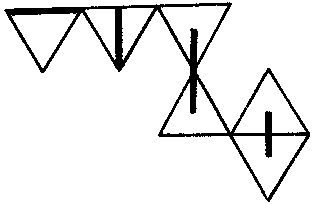
It would be easier to measure in a curved maze or in a forest; the many straight lines merely obstruct.
The general plan has an appearance of organic, irregular, gradational pattern — one ideal in architecture. Yet it has come about by the universal and strictly regular repetition of equilateral triangles. Some parts of the maze are dark. Glass panes surrounding them therefore become windows from within and mirrors from without.
In general the maze is illuminated by striplights along the tops of windows, mirages, or mirrors. These lights are not set along the top of every triangle-side, but only about one in three. They are arranged so that the pattern they form conflicts with the pattern of the mirrors and windows.
Some places are illuminated instead by a skylight in the ceiling. That is, a triangle of the ceiling is a sheet of glass — a window. Sometimes it is a mirror. Sometimes it is a mirage — that is, it is open. This nay go unnoticed till rain falls.
Some triangles of the floor, also, are mirrors. On coming to them people test them with their feet, uncertain whether they are mirages — gaps — in the floor.
(A dancer told me that when she was at high school, boys wore mirrors fixed to the toes of their shoes, so that while talking with her they could see up inside her skirt.)
Some mirrors in the floor are opposite to mirrors in the ceiling. Standing here, you see yourself infinitely reduplicated in eight directions — six horizontal and two vertical. The Glass Maze has other names:
Minglery, because it mingles people and architectural elements. (What, for instance, is the equivalent of a doorway? “Doorway” is indistinguishable from “passage,” “passage” from “room,” “room” from “court”; in another direction, “doorway” is indistinguishable from “mirage,” “mirage” from “window” and “mirror.” Both the distinctions and the boundaries between such elements dissolve.)
Marâyâ, Arabic for “mirrors.” (The singular form, remarkably, is mir'â, yet there is no possible connection. Mi- in the Arabic word is a prefix, -or in the English word is a suffix.) Tîh, Arabic for “trackless desert” and for “maze” and for “arrogance.”
Six-Way Infinity. One-Sided Infinity. Moving forward by devious ways, sometimes having to retrace your steps, you find your way into a small hexagonal space with a pillar in the middle. (This kind of space is called a circus.)

Or, taking a different route, you reach a similar space without a pillar. (This is called a hall.)

Or, pushing on farther, you are in a roofless space (a court).

In each of these, people are dancing. You may assume that you are at your goal, the chief dancefloor, which you have already glimpsed through a mass of windows and mirrors from the street. Only after remaining some time in one of these lesser centers do you discover the central court nearby.
The central court is a large hexagon, open to the sky. Each side comprises a mirror, a window, and a mirage. Each angle is a conjunction either of windows or of mirages, so that from three corners people see, and from the other three they circulate, into the closer textures of the maze around the court.

In front of the mirrors, and in the rest of the court, the crowds dance, except when rain is falling; sometimes even then. The music originates from the roof surrounding the court. On this roof, or Olympus, can be seen the instruments, such as glass trumpets, glass chimes, rubbed tumblers, and cloud-chamber bowls. (These last were used as a musical instrument by Harry Partch.)
The four musicians walk about, selecting among the instruments, and then sit on the edge with their legs dangling above the dancers. Some nights they are dressed in transparent clothes, with great shimmering wings and haloes. Other nights they are not dressed at all, but are painted black all over. Some people dance solitary in front of mirrors. They invent dances of their own. Others, standing behind them, may copy them. Others copy these in turn, forming chains of imitation backward across the court. From each dancer at a mirror, the chain of imitation extends backward (through the people behind him) and forward (through his own.image imitating him). In fact, no one dances except to a reflection of himself, in a mirror or in another person. A couple stand facing each other. One invents dances, saying “This is the Hipquake” — “the Distremble” — “the Vibroll” — “the Pripe” — “the Groundge” — “the Smounce” — “the Twince” — “the Kraction” — “the Mutament” — “the Green Charity” — “the Spreading Peace” — “the Well of Indulgence”; the other learns them. Everywhere, dancing is the same as teaching or learning; and learning and teaching tend to become the same. Does the dancer teach the mirror or the mirror the dancer? Facing couples come to move so much in harmony that they cannot tell which initiates and which imitates.
In this dancing, bodies are seen to reduplicate each other; in the old dancing, bodies were felt to complement each other; the dancing of the 1960s, in which bodies were seen to complement each other, was transitional. Other musical instruments — such as glass gongs, glass tuning forks, glass tubes filled to various depths with differently colored columns of water, glass resonators with holes for blowing across or singing into — are scattered in the court and the passages near it. Some of these instruments hang from the ceiling, some lie on shelves, some are built into the walls. Dancers may thus strike them in passing, or stop and execute longer accompaniments to the music of the professionals above. Between the playing and the dancing there is no boundary, as there is none between the dancing and other activities, or inactivity. People who are at first too shy to dance sometimes begin by finding a glass hammer and tapping a gong in a quiet rhythm. Gradually they beat louder, and move in time to the noise they are making, till they find themselves dancing. The court is a clearing in the forest of the maze. Everyone is attracted to it. When you have spent some time in it, the time you took to reach it lessens in prominence. The court seems really the building, the glasswork round about merely a fringe.
But when you press on, the memory of the court and its society and security dwindles again amid the uncertainties of the maze. The court in fact is near the beginning: the zone separating it from the street is finite, but the zone beyond seems not so.
You find other courts, as well as circuses and halls.

Some are right next to the great court, some deeper into the maze.

Some are almost as large; some are shapes other than simple hexagons.

There are places where the people on the roof must, to get from one part of the roof to another, cross points or lines between courts.

In the courts, which are open to the sky, music reaches you partly from above, partly through the maze. In all passages and spaces of the maze people dance also.
Chains of imitation among the dancers extend through courts and passages for indefinite distances. Sometimes they branch; sometimes the trunk dies and the branches are left continuing the dance independently, modifying it in different ways. Someone, facing some mirror or some partner, creates a species of dance. It may find no imitators. Or it may spread throughout the maze, and be recreated on later days and in other buildings. There is a very long slit-like court; between its two end mirrors is the longest direct reflection.

There is a pillared portico facing onto two small courts and backed by a long mirror, so that each court sees the other.

There is a court in which grows a bottle tree. (Not a bottlebrush tree — a name given to many species with conspicuous red stamens.) A bottle tree is a tree with bottles of all kinds tied to its branches.

Making bottle trees was a nineteenth century Arizona hobby, according tp an article by Margaret Magness:
Upon completion, a bottle tree, like a mobile, is never static, either visually or audibly. Besides swaying either mildly or vigorously, bottles shift perceptibly in position on the branches. Individual bottles change in appearance. The essential constituents of glass are silicones and alkalis; acids and alkalis in the atmos here cause slow deterioration with resulting loss of brilliancy and trans arency in the bottles. The passing of the wind over many bottles produces sounds which change constantly according to direction and speed of wind, size and position of bottles, and amount of rainwater collected. The combination of variously pitched, muted, hollow notes is fascinating but eerie . . . You don't know when you have come up against the outer wall of the maze, because it is lined with mirrors and thus appears the same as all the double-sided mirrors.

A mirror is one of the best means of concealment, because it substitutes another image and thus forestalls you from suspecting that anything is concealed.
Application of this to camouflage. Glass might seem the last material for fortifications; yet a fort in a jungle, for example, would be thoroughly concealed by giving it an outer facing of mirrors. It would not be noticed unless you bumped into it. Even a stray bullet that hit it and partly shattered the glass would enrich rather than diminish the appearance of jungle.
Two qualifications: mirrors do not conceal vertically (a fort roofed with a mirror would be more conspicuous to an airplane, for it would look like sky — though it might be, taken for a pool) and mirrors do not conceal perpendicularly (if the enemy catches sight of himself, he suspects doubly — though he may also get a fright).
At one point you do know when you have encountered the maze's curtain wall: there is a section where no mirror is applied to it. But, instead, a plain sheet of glass covers it — a window, though nothing is seen through it but a wall (not even air).
On the wall behind this glass are written the words “WHAT IS THIS?” And a diamond, set firmly in a small ring, which hangs on a chain from another ring, which pierces the center of the glass and is fixed in the wall behind, is provided so that you can write an answer.
Someone accordingly has written: “Transparent rock.” Someone else: “Frozen air.” Others: “A discrepancy of surfaces.” “The sometimes overlodked difference between touch and sight.” “A boundary layer.” “Glass.” “Stone.” “What is which?” “What is 'this'?” “A silly question.” “An exception.” “A graffiti-generator.” “A hope of a way out?” “A diamond on a chain.” “A diamond on a ring on a chain on a ring on a sheet of glass on a wall.” “Get out of Vietnam.” .“..on a ring on a wall.” .“..on a wall on a ring?” “Livy Jameson was here.” “The wall is the ring.” “A piece of common quartz on a ring on a chain . . . ” “Suck me — make date.” “It is hard for the sane to escape.” “A Glass Maze.“ There are places which may be considered dead ends (if you are trying to progress somewhere) or secluded niches for dancing, well furnished with mirrors. The glass maze is a diffused and fragmented dance hall.

A dance hall consisting of one huge floor is fine for evenings when enough people come to fill it. Otherwise, it seems bleak and empty even when it contains people enough for a smaller place. The size of such an establishment should be calculated to fit the number of people who will come to it, but that number will of course vary. A maze, because of being dissected into many spaces all of which merge back into each other, appears well filled wherever there are people to see. It is like a lung — not a single sac, but a mass penetrated by small chambers ready to be filled. Because of the mirrors, whatever spaces can be seen appear populated even before they are. Again, if it were a non-glass maze, people in different parts would be dancnng in different rooms, round corners from each other; but because of the mirrors, they are in communication. Indeed they feel mingled, as if they were all still together in the great court. The naive music of the public, spreading along the passages, fills halls of rebellion and courts of emulation. It sets up a ring of rival music which sometimes forces the Olympian musicians to cease. Farther off, the central music is not audible at all (there are no loudspeakers) and the amateur music continues itself independently, in divergent rhythms. You find, as you travel, yet other instruments: wall-harps; resonant hollows in the glass walls; things like golf sticks planted upside down in the floor, which reverberate when you pull and release them; a glass grasshopper whose leg you can stridulate; transparent models of a waterfall and of a bird's syrinx. “Windows” are, in the early parts of the maze, simply triangle-sides filled with plain sheets of glass. But as you wander more widely you encounter others:
Windows of colored glass.
Windows with incised and enamelled scribbles traced over them. Some of these have been used for making prints (the glass, or transparent plastic, first laid over a drawing while the lines were copied) and still have ink in the ditches or on the ridges, so that with pieces of paper you can make intaglio or relief prints of your own.
Windows incorporating the imperfections that appear in glass — “checks,” “stones,” “blisters,” “cords.” Windows of bubbly glass, of fluted glass. Dancers behind them appear analysed into impressionistic droplets of color.
Windows made of the several types of frosted glass, as used in bathrooms. One type is flat on the farther side and is on the nearer side divided into hexagonal pimples, a millimeter wide:

The pimples are themselves rounded, but the little troughs between them are straight. Fairly distant lights seen through this are scattered into a system of arcs, their shape depending on the angle of the light. Thus a light seen at a little above eye level and to the left of center (as for instance the sun soon after dawn in summer, through an eastern window) appears like this:
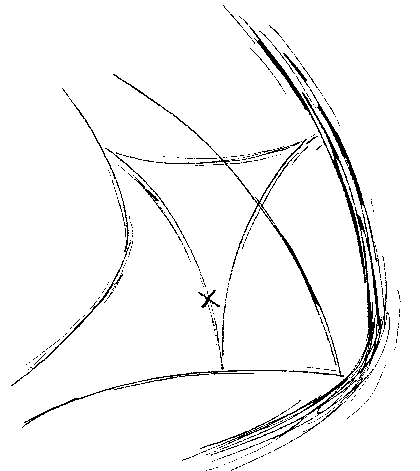
— the arcs being Milky Ways of bright points, and the X representing the place where the light would appear, if the glass were plain. All the area within the outer arc is somewhat bright. The outer arc is faintly rainbow-tinted, its outer edge blue and its inner edge still more faintly orange. The pattern covers a great angular area and gives an impression of something vast and angelic beyond the glass. Add other lights (as when street lamps are seen through such glass) and the impression is of a troop of tall interlaced presences. Splash water on the near side of the glass, and each system of light contracts into a much smaller and brighter shape in which the outer arc is more bent and the inner ones almost submerged. Flies are allowed to live in the space beyond this window. When they alight on the glass and walk about, they appear as moving inverted fans:
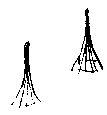
Other types of frosted glass, such as the one like a map of many little counties, yield their own effects.
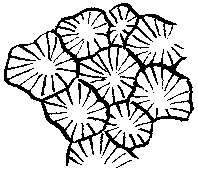
Windows of smoked glass. People behind them appear simplified into contrasting light and dark. Windows of diffraction grating, which breaks the scene into the colors of the spectrum.
Windows of glass bricks.
A window apparently made of glass eyes.
A window made of Philippine windowpane oysters.
A window not of glass but of partially stretched cellophane. Crinkly scribbles of light reflected off it hang in front of the view through it.
Instead of a window, a curtain of glass beads hanging on threads, all transparent. Another such curtain in which some beads and some threads are colored.
A curtain of beads forming a mosaic picture of a person or an animal. As you pass through it, it breaks up and re-forms behind you. You must choose where to break it, or leave it to chance by shutting your eyes.
Fine nets instead of curtains. All look the same, but some are fixed and others swing like curtains and can be passed through.
Windows made of mosquito netting or other fine mesh. Beside one of these windows is a supply of water. You throw a handful of water through the mesh. Where the water passes, it leaves each square of the mesh filled with a skin of water, so that the shape of the flying volume of water is recorded, but reduced to a grid, as in tapestry.
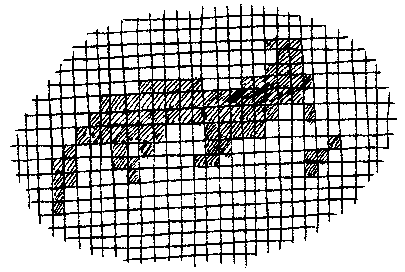
Then, as the water collects at the lower edge of this shape, large drops break loose and run down, leaving vertical columns filled by water; drops form in these columns again, lower parts of the columns drain away, leaving upper parts isolated. Gradually all the water drains away or evaporates, the last remnants being lines marking the lower boundaries of the original shape. More water is thrown; two handfuls at a time make overlapping shapes; deliberate shapes are attempted.
Windows of very wide rope mesh; in fact you can climb them like rope ladders. The mesh is still wider at the top, so that you can get through there.
Windows of reeded glass in various patterns — slanting lines, curving lines, concentric lines, rippled lines. Sliding past them, windows also of reeded glass. As the patterns slide past each other, they set up moiré effects (the effects seen, for example, in the interaction of a five-bar gate and its shadow; or between two leaves of a fan palm.
Windows of different colors which slide past each other, producing the colors of subtraction.
Simple curtains, of strong color, in place of windows. Or perhaps they count as mirages, since they are no obstacle to movement. But they seem more solid than the mirrors; amid the glass, they seem the pillars of the structure. A building supported by hanging curtains! They stand up like strong banks of orange, violet, bisque and other warm colors, matt-textured and one-distanced; wherever else your eye is directed, space oscillates in cool fluid laminations. The colors of these curtains spread and splinter in the surrounding glass. A green and an umber curtain stand some distance apart, but there is a zone where their rosettes of reflection mingle.
Finally, a window made of spiderwebs. “Versai11es,” a corridor in which a row of windows stands opposite to a row of mirrors.
 A certain court is entered by two glass doors.

These are the same as windows except that they are movable and hinged. Both have push bars on each side. But there is no “push” or “pull” notice on right or left or front or back of either door; and one of them is kept locked. Therefore you may try up to eight ways to get through. You push the left end of the bar of the left door, then pull it, then push the right end of the same bar, then pull it, then push the left end of the bar on the right door, then pull it, then push the right end of it; but not till you pull the right end of the bar on the right door does it open. All the time you are being watched by an audience of bartenders and shopwalkers on the other side, who are laying bets on whether it will take you one, two, three . . . or eight attempts. And then somone comes along and changes it — bolts the other door to the floor instead. Here and there, you discover a space surrounded by windows; a space that everyone can see into but no one can get into.

Such a space is called a cell. Some cells contain ornaments, usually a single ornament in the middle of the cell. Others contain water up to the ceiling, and fish, whose reflections, drift and dart in many neighboring mirrors. When there is no ceiling, the underside of the water's surface serves as a mirror ceiling. One cell contains only an insect. Another contains a larger animal. Another contains a small box. In another stands a tree, its crown above the open ceiling. The people who stand looking into these cells from opposite sides are often in almost uncommunicating parts of the maze.

Most cells are single triangles, but some are larger. One of these sealed-off rooms contains a rotary current of air, and sand blown in it. Another is full of mist.
There is another room full of mist (pumped into it from above) but this is not a cell, for it has an opening. From it the mist spreads steadily into surrounding parts of the maze. And some of the mirrors that you encounter:
Convex mirrors (which are of course concave on the other side.
Distorting mirrors (which distort in exactly the opposite way on the other side).
Mirrors made of diffraction grating (now it is the scene this side which is sifted into colors of the spectrum).
Smoked-glass mirrors (now it is yourself that is simplified and analysed).
Mirrors with some of the sandwiched plane of mercury removed so that you can see through. These are mirrors with a trace of the window in them.
A single-sided mirror. What is on the other side? The mercury silvering, which you can scratch away to make your own patterns.. But the other side is in a part of the maze which it takes you a long journey to reach; or, if you happen to arrive at the scratchable side, it takes you a long journey to reach the reflecting side and see the pattern you have made. It will be less conspicuous than you thought, and you will probably never find it. A mirror with scratches in its silvering shows a world of people moving one way, slit by glimpses of a world of people moving another way, both apparently in the same plane. It is as if one world is wearing thin and being dispossessed by another.
A window which is, contrarily, being shifted toward a mirror, by having patterns of mercury painted onto it. They are being painted on both sides. At first this means that each side appears as a mixture of window, mirror, and opaque mercury. But ultimately it will result in two complete sides of opaque mercury: a mirror facing in on itself, and reflecting nothing but the internal darkness of its own glass.
A district of the maze where the floor too is a mirror. Here, looking in a given direction, you see four images of yourself: the image in the wall; the image in the floor; the image reflected from wall to floor; and the image reflected from floor to wall.
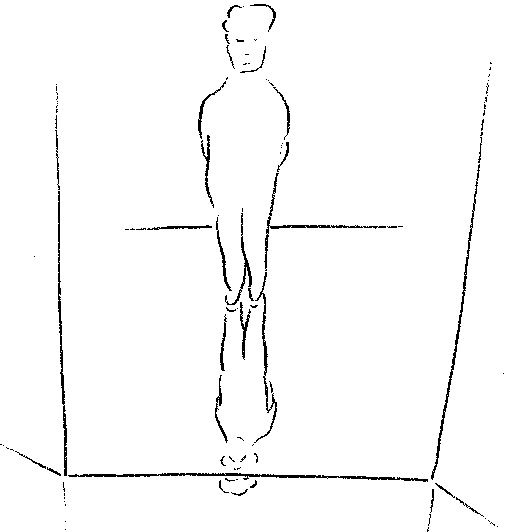
The third and fourth of these join to form an image of you upside down and without your eyes. Your eyes are at the junction of wall and floor. You can see them, however, if you open them very wide; or if you tilt your head (in which case you see one eye in the floor, the other in the wall).
A mirror across the middle of one of the triangles, from an angle to the middle of one of the sides, which is itself a mirror.

Since the two mirrors join at right angles, when you look into either angle between them you see yourself the right way around, instead of reversed as in the usual mirror image. (In each mirror you are seeing the re-reflected image from the other mirror.)
Places where you walk between a wall of mirrors and a light,

so that your shadow, and your shadow's reflection and re-reflection, and your other shadows in the reflected light and the re-reflected light, move around you. (These effects are seen more simply when you walk past a shop window in.sunlight. Any angles in the shop window are likely to be right angles; the sun's rays are virtually parallel.)

A mirror that slowly revolves, radiating chaos among all the neighboring mirrors of the maze.
A mirror slightly tilted instead of vertical. From one side — the side toward which it is leaning — you seem to see a corridor sloping upward into infinity. From the other side you see a slope down, aparently a passage leading under the maze.

A mirror in which you can actually see into an underground passage, and thence into an extension of the maze, across the street. The mirror slopes toward you at an angle of 45 degrees. It is over a shaft, at the bottom of which is another mirror; this faces along a tunnel under the street; at the end of this is another mirror; above that, another snaft; at the top of that, another mirror; beyond that, another Glass Maze. A mirror image of the Glass Maze. Each twin maze receives an infusion of images from the other by way of the tunnel.
 No rest from mirrors:
A book of mirrors. Five double-sided mirrors are hinged at the 60-degree angle where two fixed mirrors meet. The “book” therefore appears, as you approach it, to have twelve “pages.” But when you come close and look between each two pages, you see an infinity of other pages receding in either direction. Let two pages touch, and all their infinite contents are nonexistent.

(In the final footnote to Biblioteca de Babel the librarian Borges says that the infinite library he has conceived is unnecessary since it could be replaced by “a single volume . . . consisting of an infinite number of infinitely thin pages. (At the beginning of the seventeenth century Cavalieri said that any solid body is the superposition of an infinite number of planes.) This silky vade mecum would scarcely be handy: each apparent leaf of the book would divide into other analogous leaves. The inconceivable central leaf would have no reversé” — I am still struggling to understand that last statement.
(Others say that ghosts consist of surfaces alone; that fairies are weightless men and fairy gold is weightless gold; that silver is fair but gold flaxen. A knife of infinite thinness would pass through everything, but if it had no thickness it would pass through everything without cutting. Gold leaf — ordinary bookbinders' gold leaf — is l/10,000 of a millimeter thick; that is, 5,000 times thinner than a grain of salt, which you can just barely see on your palm to be a cube. You could cut a bacterium in half with a piece of gold leaf, if you could see the bacterium.)
A glass library. Books bound in mirrors (mirrors as covers). Books bound in ring binders whose spines are cylindrical mirrors: between each pair of pages you see your own long narrow face. Books printed in mirror writing, with a double-sided mirror interleaved between each pair of pages. You read the pages in the mirrors. The mirrors can be flexible leaves of silver paper. You must behold the illustrations either reversed (on the pages) or warped.(in the mirrors). Neither matters. You come to a place in the maze where you see an acute-angled corner between two mirrors. A chair is placed in the corner, only an arm's length from the apex, and facing into it. The chair is screwed to the floor, and over it stands an apparatus: a large vice. Someone is sitting in the chair, looking into the corner. He has his head clamped in place in the vice, so that he cannot move.
He unscrews himself and vacates the chair. You take your turn. You clamp yourself in place with the vice. The two meeting mirrors form another huge “book of mirrors” in front of you. But where they join, at your eye level, there is a small square hole in the right-hand mirror. Its side recedes at a different angle, and is covered with a little mirror only about two inches square. Reflected in the left-hand edge of this you see an even smaller mirror (sides half as long, area therefore a quarter). This evidently is set on the other side of the hole, the side not directly visible to you. These two little mirrors create a complex of mutual reflections at varieus angles. Somewhere among these reflections you notice an eye, looking at you.
You sit clamped in the chair for twenty minutes. Then a voice says to you through the little hole in the corner: “I've finished — you can go.“ Or you come to another part of the maze, far removed along the passages; here you are at the outside of an acute-angled junction of mirrors. The corner is broken by a still smaller slit, with a little one-inch-square mirror lining the right side of it. In front is a chair. An arm's length away, standing out from the right-hand mirror-wall, there is an easel, firmly fixed in place, with a pad of paper hanging from it and a pencil provided.
You sit in the chair and apply your left eye to the slit. You are looking into the very small mirror. In this you see the slightly larger mirror. And in that you see the face of a person sitting in a chair, his head clamped in a vice.
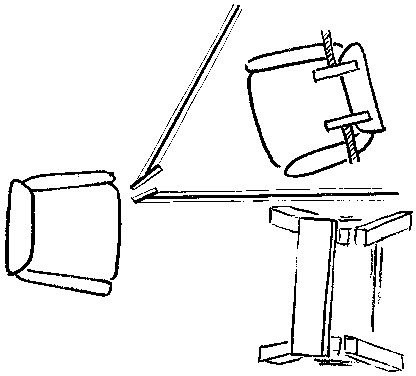
The image is the right way around, since it has been reflected twice. But, since the two little mirrors are at an angle of about 20 degrees to each other, the image of his face appears about 40 degrees to the right of where his face really is. In fact the image stands exactly where the surface of the easel is, on your side of the wall. Therefore if you open your right eye also, you see the easel (in your right eye), at exactly the same distance, height, and apparent direction. The face appears as if photographed on the paper. You take the pencil and draw over the face. This is possible only when the image keeps perfectly still. That is, the mirrors, the subject's face, and the paper, must be still (they are, because they are all, as it were, built in); your eye does nct need to keep still.
When you have finished drawing him, you speak through the slit and tell him he may go. You tear off the sheet of paper and take it home with you. You have a picture of someone you have never seen except through the portrait-slit, and probably will never meet again. (Though the chairs where you and he sat were so close together, the routes leading to them through the maze were far apart.) If you meet him again you will know his face very well, but he will know only a part of your left eye.
(It is said that the one masterpiece of a certain poor artist bears the title Portrait of a Lady With Her Head in a Vice. The artist's perpetual professional polite patience runs out: he seizes his fidgeting sitter and screws her head into a vice. Then he paints in security. He needn't hurry in fear that she will move or get bored; he needn't even entertain her and distract himself with patter. The painting is almost as gratifying as one of Rembrandt's, in which every pattern in the face is noticed, successfully pelebrated, and — most laborious of all — reconciled with every other. The most original brushwork is in the soft interior of the clamped-open mouth. And finally, since to the artist whatever is given becomes, under scrutiny, more fascinating than anything imagined — even if it is no farther away than a scorpion which the moving of a pebble would reveal — the artist cannot bring himself to unscrew or merely imagine away the vice so as to paint the shoulders, neck and hair it hides: he paints the fascinating vice itself.
(This lucky artist was not me — I haven't made the vice, but I made the little two-mirror device, set in a rough chunk of wood. It was the first of a long series of attempts at the camera lucida and camera obscura, and the most nearly usable, but someone to whom I showed it misunderstood it for an ornament and a gift.) Another instrument which might be installed in the maze is the optically folded microscope (that is, microscope with a mirror in it) which someone recently invented. It is for viewing one's own eye. Behind you, darkness; in front, a sheet of slightly smoked glass and then, three feet beyond it and exactly parallel with it, a mirror. You see a near image of yourself and a far image of yourself, superimposed. The near image is much larger and the far image stronger. The eyes of the two images exactly coincide.

Therefore what you see is the far small image of yourself, with enormously magnified eyes. These are the eyes of the near image; the eyes of the far image occupy their central point. The huge eyes overlap in the middle (across the bridge of the nose) and spread out either side of your head like a pair of wings or great pointed ears (they cover your real ears). The irises meet at the edges, and look like over-large circular eyes themselves. No matter how calmly you try to gaze, you cannot prevent yourself from looking like a terrified marmoset. Darkness. When you tread on the floor in front a certain mirror, a light above it is switched on — a kind of slowly increasing strobe light. First a single brief flash, during which your face appears in the mirror and vanishes. Another flicker, another — gradually increasing in frequency. Such flickers again, regardless of how relaxed you try to look, make you seem to stare in wide-eyed rigidity at yourself, as if you are a ghost you have seen. In fact the unexpected flashes creating your own image before you may make you think you have met your own doppelganger. The ghostly image is, after a moment of adjustment, replaced by a normal image. A small rotating mirror hangs with a beam of light falling on it. A comfortable armchair is placed before it. Sounds occur at regular intervals: a high sound, alternating with a low sound. The low sound is so low that it is part sound, part vibration through the floor. Sitting in the armchair, you fall into self-hypnosis. A stage where a magician performs tricks of the kind that are “all done by mirrors.” Two of the larger classics are the head in a box:
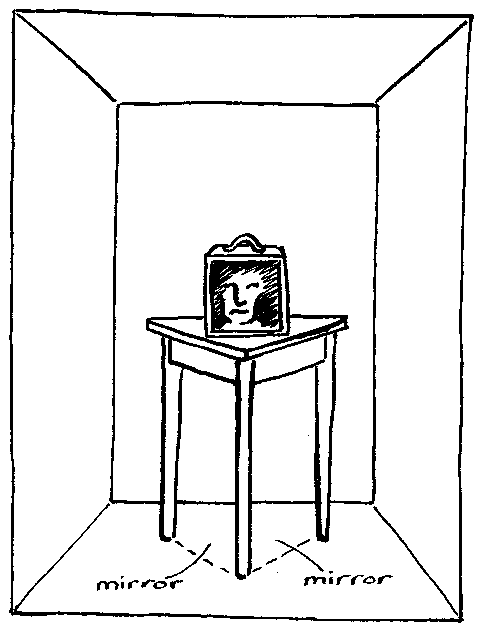
— and the head in mid air:
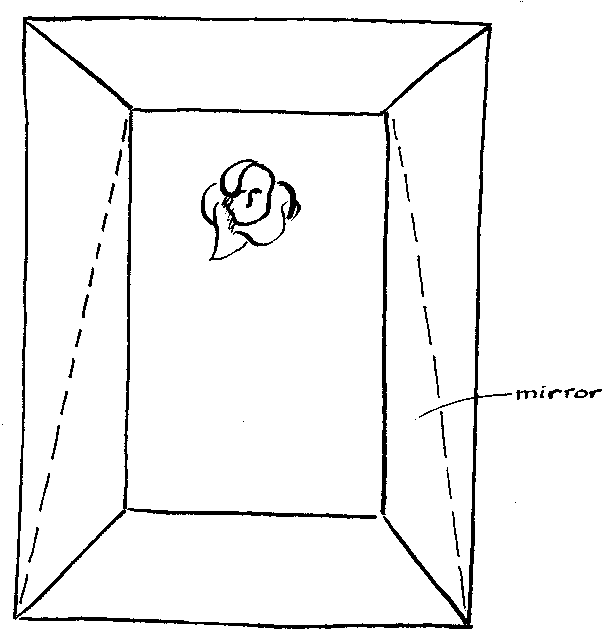
A striptease. As the stripper finishes her act, she beckons you. You hasten toward her, but find that the stage is a thicket of mirrors. You collide with them, look around for her, can no longer see a trace of her. This notice is posted on the middle of a mirror:
If during your taxable year you received a reward or payment for information furnished by you, you must report it as “Miscellaneous Income” in the Income Section of Form 1040. Such rewards include payment by the Federal Government for information furnished relating to violation of the income tax law.
Directly opposite to the mirror is another mirror, so that the notice is reflected and re-reflected, inverted and re-inverted, ad infinitum. In the middle of another mirror, also reflected and re-reflected without end, hangs a copy of an example of secondariness: the National Association of Social Workers' Commission on Social Work Education's Study Guide to Assist Chapters (of the National Association of Social Workers' Commission on Social Work Education) in the Study of the Social Work Curriculum Study published by the Council on Social Work Education.You meet someone wearing a belt of mirrors. (At first it appears to be a concho belt of silver plaques.) You meet someone wearing a mask which is a plane mirror, with straps and eyeholes. He seems to have your own face, exactly half life-size. (If the mask was not plane, he would appear merely to be a welder.) Games are played in a corridor between facing mirrors — dice; dominoes; backgam on; go; chess.
One of the more slippery of our words is “between.” Someone told me: “A steeplechase was originally a race between steeples.” A note I wrote after a dream said: “Lovemaking between mirrors.” Since it was a dream, I am not sure which reading was correct. Because some people perforce remain in the maze many hours, services must be provided. The washrooms are well furnished with shaving mirrors and makeup mirrors. On the glass counter of the restaurant, in glass dishes and bowls and tumblers, are served clear soup, aspic jelly, crystallized fruits, glacé cherries, vodka with ice.
 The Liquid Maze: a region where the mirrors and windows are all hinged. They swing in the breeze that stirs from courts. A whole triangle of solid clear glass; that is, a huge prism.

It refracts into rainbow colors, and also its internal surfaces acts as mirrors.
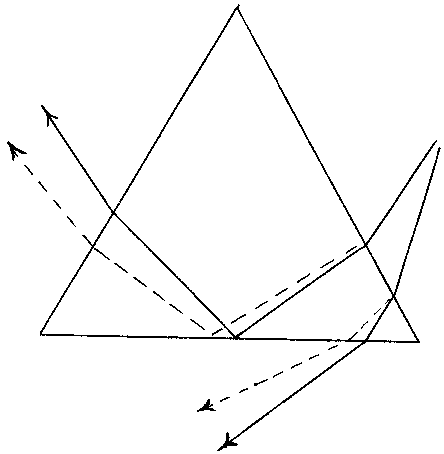
Besides the equilateral prism, a right-angled prism is possible in the maze of equilatera] triangles.
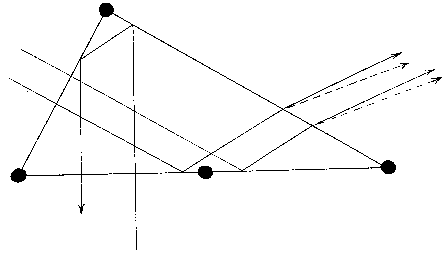
But not an isosceles right-angled prism, the kind that can act as a periscope, or as a mirror giving right-way-round images.
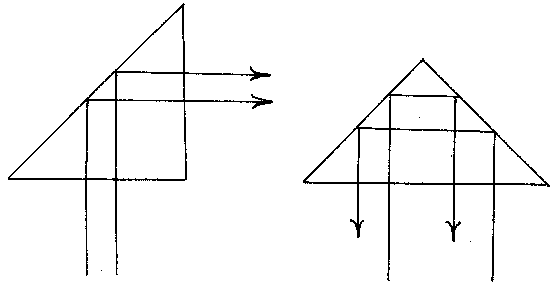
Two triangles filled with standing sheets of slightly cloudy glass, so as to form a solid rhomb. Light penetrates rather more than half way. It seems like a wall that indeterminately fades inward to inner darkness; a fogwall. Your range of vision overlaps with that of someone on the other side; you are both looking at the same central mass of glass, but neither can see out to the other side.
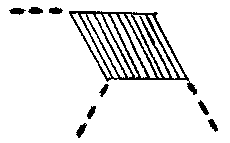
A triangle filled by a large model of a piece of country, in deep intricate relief. The model has been made from many copies of a contour map, by cutting each copy along a different contour. Then the pieces representing one level are mounted above those of the level below. It seems as if the thin paper shapes rest in the air one above another like a stair of flying steps. Actually each is glued to the top of a sheet of glass. The model is contained inside a triangular stack of horizontal clear glass plates.
(A model of this kind, German-made, is on a shelf overlooking Meteor Crater in Arizona. A model made by me on a slightly different principle, ofa district in England, may still be in existence in the School of Military Survey at Hermitage, from which I once tried to steal it back.)
A niche, from each of whose three mirror-walls protrudes a battery of tubes.

The distal end of each tube is set in a hole in the wall; the tube can be swivelled by moving the nearer end, which is an eyepiece. On looking into the eyepiece, you see that the tube is a kaleidoscope, of the type which has at the far end, not a piece of ground glass and some colored fragments, but a lens which collects an image of whatever lies beyond.
(This kind of kaleidoscope is sometimes called a teleidoscope, since its lens makes it a kind of telescope, and since the image is of something far instead of something inside the tube. Kaleidoscope means “beautiful-image-view” and might more strictly be polyeidoscope, “many-image-view”; teleidoscope is “far-image-view” and might more strictly be telepolyeidoscope, “far-many-image-view.” Teleidoscopes, which make people somersault in sixes, and binoculars, which make cars run into your lower belly, are sometimes used for a psychedelic experience by car passengers or even drivers cruising along Mulholland Drive, or down La Cienega Boulevard at night, and in this context they might be called collideoscopes.)
When you look into one of the teleidoscopes, you see a bright square image, surrounded by darkness. Everything in the image is jittering about, but yet retaining symmetry in both directions. This gives the visual clue to the fact that the square is divided into four triangles, each of which is a reversed image of its two neighbors, and a reversed and inverted image of its opposite triangle.

You may be able to work out that the tube contains two mirrors, set at a right angle. One triangular image is where you are looking straight between the mirrors to the lens. This primary image is therefore inverted and reversed. The two alongside it are the reflections of it in the two mirrors. The fourth triangle, opposite to the primary one, consists of half the reflection of the left-hand mirror in the right-hand mirror, and half the reflection of the right-hand mirror in the left-hand mirror. This tertiary image is the only one that is the right way up and the right way around. If you look carefully, you may notice a slight line of blur down the center of this tertiary image. This blur, if you refocus your eyes on the glass foreground inside the tube instead of on the distant image in the glass, is seen to be the physical join between the two mirrors. If the accuracy of the right-angle between the two mirrors were infinite, no blur would appear. Also you may see that the tertiary image is slightly dimmer, and the primary image slightly brighter, than the secondary images. Since there are only two mirrors, the third side of the triangle between them being closed only by the dark inner surface of the tube, this surface is reflected and forms the blackness surrounding the whole pattern. If the lens is seen through a straight-edge window, the total image will be square, but if the whole round lens is seen the image's edge will be a circle — less interesting because it will be the same in all the other teleidoscopes.
For all the other teleidoscopes are different from the one you have just looked through, because of the number of mirrors in them and the angles between the mirrors. Examples, in order of decreasing simplicity, of two-mirror teleidoscopes:
— 90 degrees (1/4 circle) between mirrors, resulting in 4 images, forming a square. This is the one already described.
— 60 degrees (1/6 circle); 6 images; total image a hexagon. There are now 2 secondary images on each side.

— 45 degrees (1/8 circle); 8 images; total image an octagon. The number of secondary images increases by 2 again to 6.

— 36 degrees (1/10 circle); 10 images, forming a decagon.

— 30 degrees (1/12 circle); 12 images, their still narrower triangles forming the radiating sectors of a dodecagon.

With still smaller angles, the secondary images multiply like the folds of an opening fan, all repetitions of each other. Intermediate angles, such as 40 degrees (1/9 circle), cause the tertiary image — the only unreversed and uninverted one — to be absent or incomplete.
Then there are three-mirror teleidoscopes, in which the third side of the tube is a mirror also. Therefore, instead of being bounded by darkness, the pattern of reflection extends outward without limit except the sides of the eyepiece. Examples:
90 degrees in one angle between mirrors, 45 degrees in each of the other two. The square of four triangles, instead of being bounded by darkness, spreads outward indefinitely. Instead of only one right-way-up right-way-round image, it repeats itself by double reflection along a line downward and a line upward.
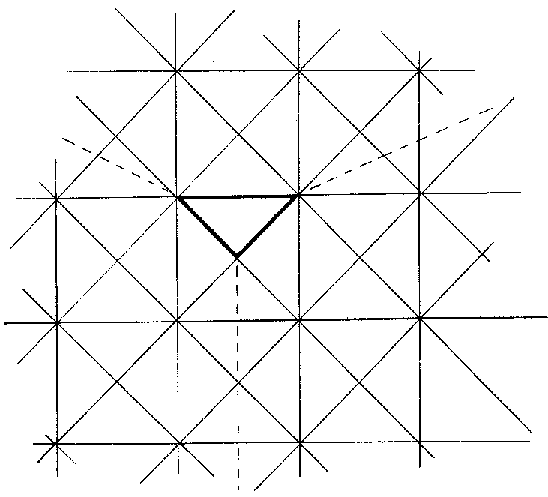
— 60 degrees between mirrors. The pattern of triangles. or of the hexagons they compose, spreads outward infinitely (like the Maze). Right-way images recur outward along six radii.
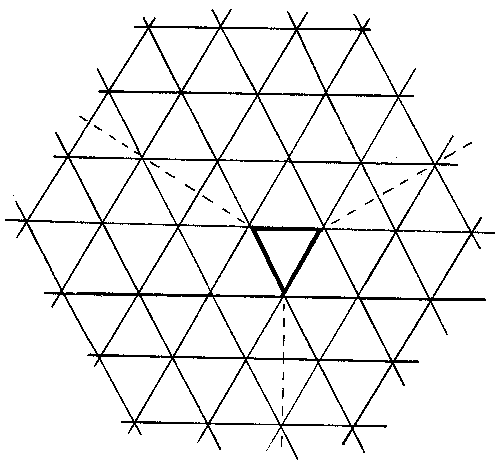
A four-mirror teleidoscope, in which the mirrors are set in a square, sets up a spreading pattern of squares, each image diagonally off from a corner of the central image being a right-way one.
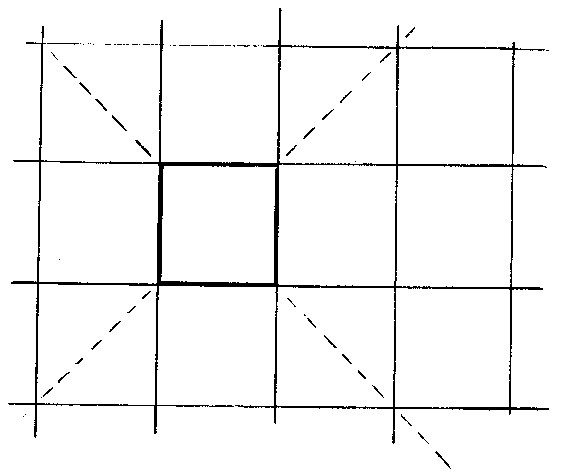
And then there are two-mirror teleidoscopes with their mirrors unequal in width, forming triangles and stars or rosettes;

three-mirror teleidoscopes with angles of 90, 60, 50; three-mirror teleidoscopes with a fourth side open; and, in fact, an infinity of possible machines generating polygons and nets of polygons and producing their internal infinities. Each of them is a reduced Glass Maze of some new type; a Glass Maze in a box, a Glass Maze in the eye.
The images in them, instead of being head-to-foot people, are fragments, and thus harder to understand. In the teleidoscopes that protrude from the wall in front, you see moving colored shapes that you eventually understand to be a mobile, hanging in a cell. (The cell itself, of course, is walled in by three mirrors.)
The teleidoscopes on your left show textiles, almost unrecognizably different when near and far, in light and in shade; also noses, thumbs, eyebrows, ankles. You are looking at people coming and going along a corridor in the maze.

The third battery of teleidoscopes, on your right, shows similar fragments of flesh and clothing, and heads of hair and intercrural shadows, but moving more complexly. Youzare looking in on a court where people are dancing.
When contemplating the mobile imprisoned in its breezy cell, you may notice in the opposite wall a lens. Usually it is dark, but there is a brief time when the shadows move in it and it is occupied by traces of an eye. It is the lens of another teleidoscope. Is it set in another room of teleidoscopes, and on what do the other teleidoscopes there look out? Elsewhere, a device of another kind, between a kaleidoscope and a teleidoscope, for the thing seen is neither within nor beyond, but painted on the glass. It is a number “2.” Its rotations and their reflections appear in different patterns according to the number and angle of mirrors, but may be tabulated thus:
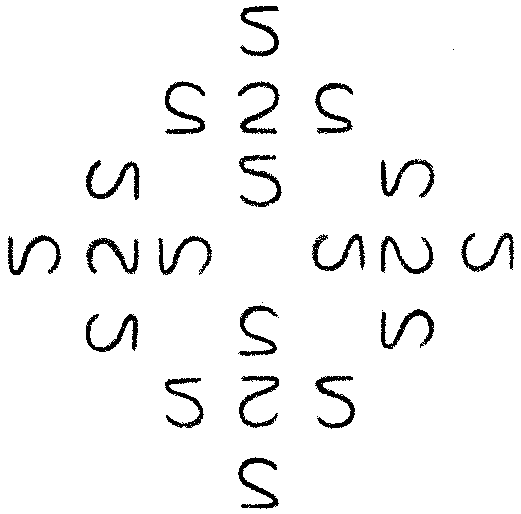
In this network other symbols — Z, 5, S, n, u, N, ~, ç, Omega — seem to appear, and it is uncertain that 2 is the basic one.
Other static kaleidoscopes, containing other families of symbols. Ornaments, in the maze, stand on glass shelves or the glass floor, in niches (between two mirrors) or cells (between three windows). Their colors locally stain the maze, like blood in water.
Paperweights. Mathematical models. Rock crystals. A vitrine (an article hardly ever seen except at auctions: it is a window-fronted and mirror-lined case for display of an ornament).
Pieces of colored glass pressed into nets of lead (which can be bought in malleable strings for this purpose).
Piggins, rummers, pcsset-pots, tavern drams, Dutch puzzlejugs and trickglasses, ogee bowls, Janus-bottles, lacrymaries; crizzled, scale-gilt, quatrefoil-knopped, balustroid, ladder-moulded, ruby-flashed and wrythen vessels of soda-metal, hyalith, millefiori, crackleglass, and pâté-de-verre, with spiked kicks, spired rims, milled trails, plume-prunts, opalescent stems, spiral tapes, multi-ply corkscrews, rim-blazes, vermiform collars, winged flammiform gadrooning, double-series air twists, and domed, folded, terraced, petalled, double-blown, overstrung or oversewn feet. Timeless Hebron glass, blue, brown, and wine.
An Italian vase, its general color seeming brown. But this brown is composed of the many colors of the ancient glass's imperfections and decay: red patches, rainbow undulations, green and blue strata, yellow rings like wood, grey metamorphoses, black where flakes have fallen away. A hollow crystal of glass or transparent plastic, filled with clear mineral oil. In the oil are thousands of tiny green hexagons of a shiny material. When the cystal is turned upside down or tilted, the green particles hover, then the majority pour with a slow slump to the bottom, then the rest straggle more slowly down through the thick medium, and in about a minute all have settled again. The crystal is lens-shaped but with facets around the edge — that is, it is cut in the “brilliant” form of gems — and because of refraction through these facets the apparent number of the green specks is multiplied and the parts of the crystal which are upward never appear to be entirely free of them.
The oil crystal is placed in a hole through a window. It is pivoted at left and right. People on either side of the window can see it and invert it. When it is half inverted (horizontal) the green fragments, seen through the faceted edge, appear more ubiquitous, and of uncertain distance. Another oil crystal is pivoted in a hole through the ceiling. The shower of green particles seen from beneath is like suspended rain or a puff of current in seaweed. The oil crystal in the ceiling has to be inverted by someone with a long arm or by the people on the roof. An area without lighting. It is a dark sub-maze, surrounded by mirrors. Light diffuses only a short way from the entrance.

But somewhere in the dark maze you
stumble upon a triangular table on which are candles and matches.
There is a mixture of mirrors which multiply your candle, and windows,
through which you see others' candles moving. A candle-under-lit
face, as in a chiaroscuro scene of Caravaggio or Honthorst or Quentin de la
Tour or Joseph Wright of Derby, travels hanging in the darkness;
duplicates of it glide toward it, away from it; faces of this set
are extinguished, others light up; all turn an angle, like servers
before an altar; other sets (each the tallies of one face) interglide
it. In the light maze all this happens and more — too much more.
Sometimes, too, someone strikes a spark in the dark maze. It falls from the ceiling to the floor, tearing every mirror. You are momentarily undecided between fireworks and a meteor shower.
Glass in darkness: is it at rest? (This question, irrational as it may be, occurs strongly when after being impressed by the power and delicacy of the ground, coated, fused-quartz optics inside a telescope, you put a black dustcap over it.)
In this and other regions which are dark, wanderers do not communicate with the main body of the dancers by sight; in its absence, sound becomes more prominent. So does such light as there is. You grope in a brownness, made softer and warmer by the absence of everlasting glassy glitter. The murmurs and music to which you attend are farther off than they could otherwise be. Scales of reflection appear far off, and you try to determine the point on your horizon around which they concentrate and are least dim, and to move toward it. A projection room — a hexagonal cell surrounded by windows, where someone descending from the roof operates machines which send out beams or colored projections of various kinds in all directions. In this part of the maze, steady lighting from above is absent, being replaced by these inconstant horizontal illuminations.

A projected picture strikes a screen formed by adjacent windows of smoked or ground glass. The image appears on the front of this screen and also on the back, in reverse.

A white beam — sometimes, instead, a colored image — travels into the angle of two mirrors, and is split in two directions.

A beam enters an almost enclosed room of mirrors and is detained inside it.
Projections fall on other types of windows — gauzes, curtains; on curtains of beads and laces, so that you can part the moving image and walk through it, carrying a part of it with you; on steam filling the entrance to a room; on a dark doorway with nothing but darkness far a long way beyond, so that there is no image till it appears on the bodies of people walking through.
Shadow puppets, suspended from above and operated by the roof people, interrupt steady floods of light travelling to rear-projection screens. Some of these puppets are solid silhouettes. Others contain colored glass, so that they cast shadows with purple coats, blue eyes, red hearts.
(In Indonesia the Wayang puppets are seen directly by men on the hither side of a screen, but as shadows by women on the other side. In Turkey the shadow puppets in the plays of the Koroglu cycle are made of animal hide, scraped and greased till it is transparent, and then painted with colors.)
Pencil beams of white light are sent horizontally along the surface of a dark wall, on which they appear as white lines. They encounter a wheel on which are fixed a straight mirror, a convex mirror, a concave mirror, a convex lens, a concave lens, a prism, and perhaps other optical pieces. As the wheel goes around, the reflected, focussed, spread and refracted beams swing over the surface like small searchlights.

A large ball covered with little mirrors. It hangs from the ceiling and rotates. A beam from the projector is trained on it, with the result that flocks of reflected lights revolve through the surrounding space. Bright points or flakes fly slowly across near surfaces (walls, ceilings, floors, people); diffuse webs of light flit across distant ones. Through windows, these lights invade more remote corridors; off mirrors, they play back across the space or out of it, moving in contrary directions, and bringing inexplicable motion and scintillation to places from which the revolving ball is not visible. If they were still, none of them would be noticed. Another such ball stands on a turntable set in the floor.
(These mirror-studded balls hang in old-fashioned dance halls, where the spotlight is trained on them during the waltz.) Brilliants and other gem-shapes of clear and colored glass, set in various windows in the neighborhood of the projectors. Putting your eye close to one of them, you look through to the revolving mirror-studded ball; through another you see a candle; through another, a beam direct from the projector. Each of these lightsources is transformed by the facets of the gem into a geometric pattern, often like a candelabrum. Windows of polarized glass. To these are fixed disks of polarized glass, pivoted at their centers. People on one side of the window may stick bits of transparent tape to the glass; these produce colors. People on the other side may rotate the disks; the colors then change. At certain angles, the circles go black. Sculptures in glass. This is a possibility not yet much exploited for its own sake. Ornaments have long been made of glass, but almost always in relation to some use, even if it is only that of an inkpot or a tiepin. Sculptures that might have been made in wood, stone or metal have been made in glass, but usually for the same endowments of texture, curvature, displacement.
Glass shows an interior as well as an exterior. The interior, being a volume, is infinitely larger than the exterior which is a surface. (Recall the speculative man who said that a solid body is the superposition of an infinite number of planes.) In glass sculpture, internal frontiers are visible as well as external ones. A sculpture of a stream may show the convolution of its currents inside it, cloud-shaped and needle-shaped, warm and cold, as well as the impressions made in it by pebbles and weeds and the spaces taken from it by fish. A didactic sculpture may tabulate ideas in three dimensions — (a + b + c)^5, the color solid, Turkish vowel harmony, political types, the relationship of the sciences. An abstract sculpture may set up structures unconstrained by meaning or by what actually happens when functions meet beneath a surface. The germ of true glass sculpture exists in children's marbles.
Life-size glass sculptures of.people making love. Sex cannot otherwise be fairly treated. Its kernel is the penetration of one body inside another. Opaque representations must either imply this indirectly, or give an unbalanced general picture by showing only the inessentials that they can show directly. The worshipped breast is hidden by the hand that worships it; instead of the woman, subject of worship, the man, instrument of worship, is mainly seen, and this neither would wish; the foci of worship are hidden deepest of all, central in the double being.
The female glass may be clouded with one tint, the male with another. Or they may be tinted on their inner surfaces. Or each may be filled with an electric glow of its own. In this way, light acts for the precluded sense of feeling. By light the spectator senses the distribution of both whole bodies, which the inhabiters of each would sense by touch and weight. (At orgasm one can seem to envision the whole body of the beloved, all the organs, es if in glass.) The light rises and falls in different members as intensities of consciousness wander. White liquid, simulated perhaps by light, overflows from one transparent body into the other. On a glass shelf high against a window, with clear light beyond, are set several bottles of colored water. One is a golden red; another, turquoise; another, the cold smoky brown of a very dry sherry; another, a rich blue tending to indigo; another, pure yellog. The bottles are of various shapes. The shape creates panels of different intensities in the yellow. Where the brown and the blue overlap, they make a black.
From time to time bottles are removed, and put back full of clean water. They are removed and replaced from above, by hands coming through an opening in the ceiling. Then the same hands color the water. Using little bottles of red, blue and yellow food coloring, they shake one drop at a time into the water, or at most three.
A red drop falls into the water. It forms a small downward column, which halts and spreads into a flat puff. From two or three points in this, secondary columns descend, and halt, and spread, like little inverted parachutes. So the red veins filter downward through the bottle, dividing and redividing, choosing various paths and levels. As they enter the almost imperceptible eddies of movement in the apparently motionless water, the red veins lift and swerve and film themselves into slow swirls. All the time they dilute as they occupy more and more of the water.
A blue drop is released next. It descends and parachutes and redivides and swirls in slightly different ways; it threads among the red columns and levels and curtains, sometimes avoiding, sometimes mingling to make brown.
These bottles of colored water are most beautiful when sunshine comes through them and they are seen at least partly through gauze curtains; or when what is seen is their light staining and spilling through a curtain of heavy brown thread with a wide mesh; or when candles are behind them. Glass dishes of water in which pillars, multiple lenses, and walls have been constructed of other liquids (such as silicone, benzene, paraffin oil and carbon disulphide) which do not mix with each other or with the water.
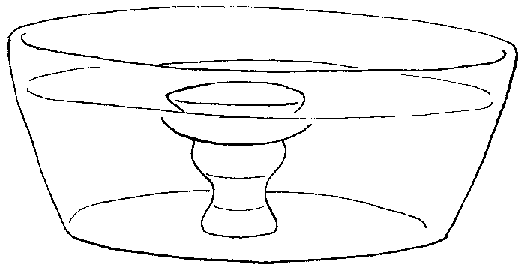
(The methods for doing this were described in Scientific American in iate 1958.) A sheet of water flowing down a mirror. It loosens the reflections.
Water flowing down a window. It flows down one side, but it could be either side.
A sheet of water falling freely through the air into the colored slot which marks a triangle-edge. It simulates a window.
A window of ice. As you face toward a window, a jet of water comes at you. You cringe, but it strikes the window. The water comes again in bursts, some narrow, others diffuse.
A glass room where you stand with jets of water rushing harmlessly at you on all sides.
A window with hoses on both sides. People haye mock waterfights, aiming the hoses at each other; all the water runs down the glass.
From some hoses comes tinted water. People on one side play, for instance, yellow water, against the others' blue water, which they then change to red. The colors appear to mix on striking the glass; but mix in rippling, uneven ways, shot through with light, and retain also their purity.
At moments judged by,them, the managers on the roof withdraw the glass wall like a portcullis. The colors really mix, clashing in mid air; the people on either side fo: a moment do not believe it, till they find themselves drenched and colored. The warm colors turn out to be warm.
A light is directed toward a place where people stand. Between the light and the people is a window, leaning slightly from the vertical. Water flows down it. This causes waves to seem to flow down the people on whom the light shines. They see each other, looking like faint tigers, except that their stripes always move down from their faces to their feet and are renewed again at their faces.
A pile of froth is made with water and detergent, and thrown against a window. People on the other side look through it. A contact microphone set beside it broadcasts the continual crackle of its decay. Waving your hand across the froth causes a momentary roar. A hexagon containing a hot bath. It is surrounded by windows, with a glass door. The naked people bathing are invisible to watchers outside, because the glass steams up.
But sometimes one of the bathers flings a palmfull of water at the glass. Instantly, where it splashes, a jagged patch of glass is clear. In bright colors (by contrast with the silvery blur through the condensation) those who stand just outside at this point and moment see the naked bathers, who in turn see the faces that see them. But the image ripples as the water flows down it, and when that ceases the fading begins, as the steam reasserts itself. A glass pool, people swimming in it, a glass terrace alongside, where others watch.

At one place in the pool there is a submerged circular glass wall or bowl, rising to within an inch or two of the surface of the water; within it, at the bottom, a rotor. It appears as if a cylinder of water is spinning, without involving the water that surrounds it.
A strong narrow beam of light shines upward from the bottom of the pool. It shines not vertically but at an angle. As it passes out of the water it is refracted.
 A downward-sloping passage. Views into the pool through its glass side. The pool is being constantly filled. So there is constant overflow — a sheet of water pouring down the wall beside you, running away in a narrow channel.

Another beam of light shines downward on the pool at an angle, near the glass side, so that it passes out again. It is refracted both on entering and on leaving the water.

The slope continues downward till, passing through the curtain of overflow, you come to a place where the pool is overhead. It is seen through its glass floor. A fish's eye view: you can see upward through the surface of the pool only in a circle, outside of which you see the underside of the surface, acting as a mirror back into the pool.
While you look upward, raindrops fall on the pool, for it is unroofed. The pool narrows to a lane of water, a sinuous canal composed of watery triangles of the maze.
At first, you may walk beside this canal. You are careful not to walk into it: the boundary between triangles of floor and triangles of water is — like any boundary not occupied by glass — a mirage. The water is flowing gently along, not because it slopes, but because of the constant inflow into the pool which is its source.
The bank on the other side is a sloping mirror, half in and half out of the water. Looking across, you see your image, the upper part normal, the lower part floating upward because of the “bent stick” effect of refraction. The water acts as a prism. Stooping, you see red upper margins to your lips and eyebrows, blue lower margins. In one place a powerful white light shines down onto the underwater mirror, or, by day, a shaft of sunlight through the roof. It is projected as a rainbow on the opposite wall above the water.
The canal meanders far through the maze. Walking, you find yourself again beside a reach of it. Swimmers are still following its course.

But now it passes under a bridge. This being merely part of the floor of the maze, there is no air gap: swimmers must submerge for a triangle's breadth and emerge on the other side.

In places, walkers must step across the water by a bridge which is only a point, where triangles meet.

Swimmers who can pass the bridge continue along the canal, which leads them back to the central area of the maze, near the main court. The water still leads on, but they have to submerge increasingly often and it is more and more difficult for them to find their way. You may see a swimmer pass — emerging and re-submerging — through a watery cell surrounded by windows.
 Movable mirrors, set in slits in the ceiling, introduce the images of the sun and moon into the maze.
A mirror, moving in relation to the maze but fixed in relation to the universe, faces Arcturus, even when it is hidden underground or is lost in daylight.
The maze should be connected to the universe by an observatory and an orrery. But at any rate, in the stead of both of these, there is an area of the maze called: The Glass Planet. This name is written on the door leading into the area.
In this area there are no lights. The ceiling is all windows, so that at night you see the stars through it. The floor also is all windows (not mirrors). Deep below it is a gigantic screen. On this is projected a moving film of the other half of the sky, taken by a fish-eye camera in the antipodes at the same time of the night six months earlier.
So it seems that, instead of seeing only half of the celestial sphere, as from our opaque planet, you can see the whole of it — the view from a Glass Planet.
The walls surrounding the area are mirrors, including the door you came in by. These seem to be just the glass walls of a yard on the Glass Blanet. They reflect each other, and part of the sky above, and part of the sky below. They mask the glow and haze around the horizon.
Actually, this view of stars all around is the view from a Glass Planet which is far away from the sun. Toward dawn, the sky brightens on both sides (east above and west below, the latter being east if you stand on your head); then the sky above brightens and loses its stars, and so does the sky below, as the film from the antipodes conpinues. A sun rises on the east, another drops out of the western horizon. Apparently the Glass Planet has a very rapid and very eccentric orbit: in six hours, it rushes from as far out as Pluto, passes midway (and diagonally) between two stars at the same distance as the earth is from the sun, and then in another six hours it swings out to the distance of Pluto again.
What about the view toward a glass planet? It would be invisible, except for the observers on it and the small twinkles on it representing the reflections of stars on its curved surface. Thus each star in the sky, except for those seen through or near the glass planet, would be seen twice: direct, and reflected. Since stars are seen only as point sources of light, the reflection would seem identical, but farther away. Perhaps clusters like the Pleiades, Hyades, Praesepe, Coma Berenices, h-and-? Persei, and the globular clusters, are not far-off clusters at all, but very nearby glass planets reflecting stars from all directions. Perhaps there are very few stars at all, the rest being their reflections in glass masses crowding near us. You come again to a niche through whose three walls teleidoscopes look — now, however, only one in each wall. The teleidoscope on your right looks in on a mobile; it is the same you once saw from the other side.

The teleidoscope in front looks on many insects buzzing in a cell of mirrors. But the teleidoscope on your left has for the elements of its image flesh — parts of the naked flesh of two people. You are looking in, though perhaps you cannot be sure of it, on a room of mirrors where two people are making love, a bower. Dancing or wandering away from the more crowded parts of the maze, a couple happens to find a mirror standing slightly ajar. It is in fact the door to a bower, but on the outside it has no handle: only by being ajar is it revealed as a door. If they go in and pull it shut behind them, it is perfectly disguised on the outside as a plain mirror.
The bower is a hexagonal room. Its floor is a continuous mattress. Its walls and ceiling are all mirrors of the pink-tinted or gold-tinted kind which make people seen in them look unusually healthy and handsome.
The lovers are reflected in seven directions. In six of them stretch infinite lines of females, infinite lines of males applied to them. Could this moment of infinity supersede the promiscuity of a lifetime?
Apart from anything which has to do with more than one person, a bower is welcome as a refuge from the maze's eternal glassy hardness. There are bowers of other shapes and with other fitments. All are based on the group of three triangles, in which a person or two persons can lie at length.

Some are designed to facilitate only straight (in two senses) intercourse;

others, junctions at angles;

another, a chase around an islanded glass case containing a Greek urn, on which is figured a satyr chasing a nymph.

(In all the history of erotica, what has been invented more outrageous than this respected motif?)
A bower of seven triangles contains a mattressed plateau, a slope down which warm water runs, and a bath of one triangle.

Someone has written for me the specifications for her bower: .“..shades of purple and blue and burgundy glass, with tinges of white-silver, giving a feeling of great depth and intimacy, and no sense of time . . . Some panels would revolve, but so slow that you would have time to draw the image seen in them . . . There would be glass cut so that it would be as if thousands of candles were flickering.“ A court-bower, a bower which is a private court open to the sun or rain.

A court where couples wait for the nearby bowers. One of these has no door. If you can find no other vacant, you may dare to use this bower. Its open doorway happens to be on a line of sight, through windows and a sealed-off cell, from a corner of one of the large courts near the center. This glimpse may be people's first inkling of the existence and use of bowers.

But a bower of honor opens onto the main court itself, by two adjacent doors.

The crowd in the court may not know it is there, even when the doors open and someone slips out; or they may await this event and set up a cheer. Not far away is another bower with two doors. One opens into a court near the center; the other, into the remote outer maze.

Another bower has two doors, and if you come out of the wrong one and shut it behind you, you are in a circuit from which you may never escape.

There are paired bowers, divided only by windows.

There are bowers with sculptures in niches.
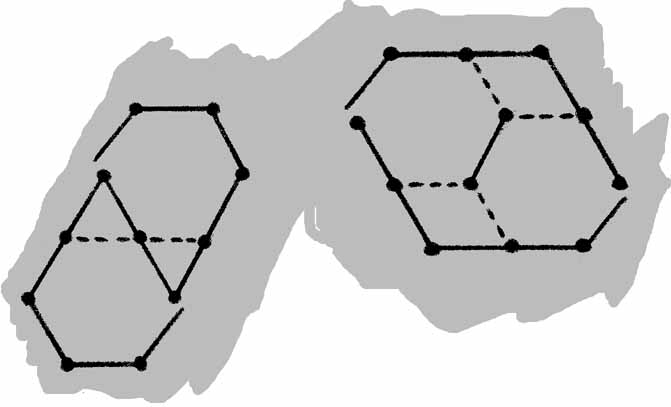
There is a bower for exhibitionists.

No door closes its doorway; it is open to the sky and the people on the roof; one of its sides is not a mirror but a window from a neighboring courtyard. Moreover it is the route of access to the next bower, which has a niche with a window back into it.
There is a bower with no light switch in it. When you enter, you see a curious small cloudy light glowing opposite to you in the darkness. As you shut the door, the light vanishes. Groping to it, you find a structure arranged like a clam or jaw. It is two concave (magnifying) mirrors, round and quite small, joined at a narrow angle. Light reaching them through the doorway is thrown back and forth between them, spreading, and thus causing the glow.
A slightly flexible mirror forms the door to a bower. It has two handles on the outside, one at a top corner, the other at the bottom. When you pull either of them, the mirror bends. You and your partner appear to sway and liquefy, before the door opens and you enter.
There is a bower with a keyhole in its door. This bower is next to the maze's outer wall. When a couple leave it, they push the key through a slot in the wall. Out in the street, you may find this key in the slot and possess yourself of it, thus booking the bower. Then you enter the maze and find your way toward it. After lengthy search, you see, through a window, the door with the keyhole,

and, knowing you are near, you enter the passage which is the final stage in the approach. But this passage consists of thirteen distorting mirrors. You pass between them, seeing yourself and your partner swollen, shrunk, cleft into blobs, cleaving together, faces insane and bones ductile. The thirteenth distorting mirror is the door itself; it parodies your struggle as you put the key into it. The mirrors surrounding the inside of the bower are misshapen too. Desire thus tested may not survive; or, the droplets and arabesques derived from the transformed bodies may become an enriched painting of passion. There are bowers islanded by corridors. People go all around them without suspecting their existence.

There are niches deep among areas of mirrors, where you may come and wait, convinced that if you wait long enough one of the mirrors will open, proving to be the door of a bower; but none does.

There is an islanded bower surrounded only by windows; but those outside see little of what is inside, for the windows are covered with running water. As you come in you are drenched, and strip the wet clothes off.
 Deeper into the maze, mirrors gain in frequency over windows and mirages. The maze is denser: reflections crisscross the air more closely; the proportion of glass to air increases, since mirrors are thicker than windows and infinitely thicker than mirages. Open courts die out. They are roofed and doored to fill the demand for bowers. No triangle-node is without a glass-studded column, except inside bowers, which are hidden within their mirror walls.
The bowers, while their doors are shut, are as if nonexistent to the surrounding maze, subtracted from it. They are castles of privacy defended by unsuspectedness, bubbles in a rack of froth, jewels yet harder set in the hardest parts of the rock. They swallow up what goes into them, like the “black hole” stars posited by astronomers, or like Don Quixote's room full of courtly and perverting books which his relatives sealed up while he slept, so that he felt all over the wall with his hands and found no trace of it.
In the intestinal corridors you cannot rest. You can rest only on attaining a bower.
You have lost all sense of direction. Thinking you are moving in toward the bowers, you may drift out to the street.
The broad form of the maze is like this:
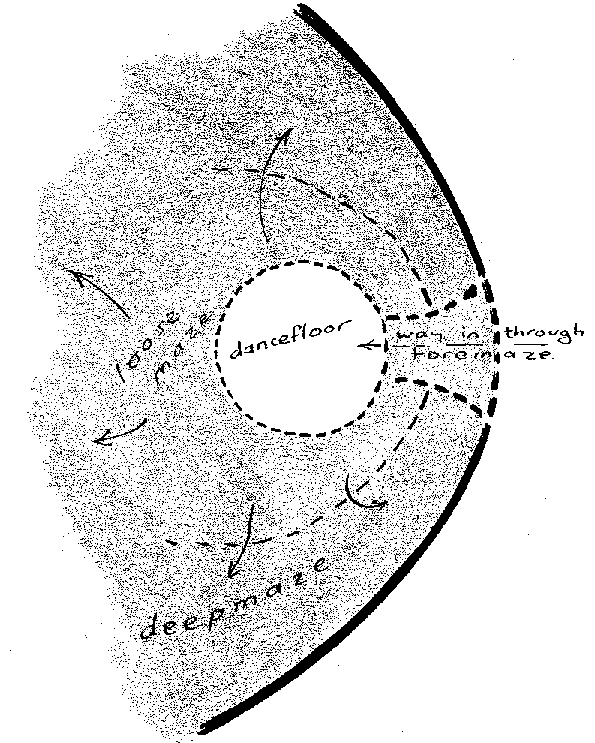
There is gradation from open air (the street, a tangential line) through mingled elements to the dense web of mirrors. There is gradation from the publicness of the street to the socialness of the central hollow to the privateness of the crust. There is radiality or spirality. There is a single vast plane on which people move, a Flatland, but it is punctured by entrances and viewholes from a plane above. There is a suspicion of infinity. There is a hard simple atom (the triangle) into which the broad form resolves. There are glass deceptions. All these things link the Glass Maze to certain other buildings.
There are names for localities in the maze:
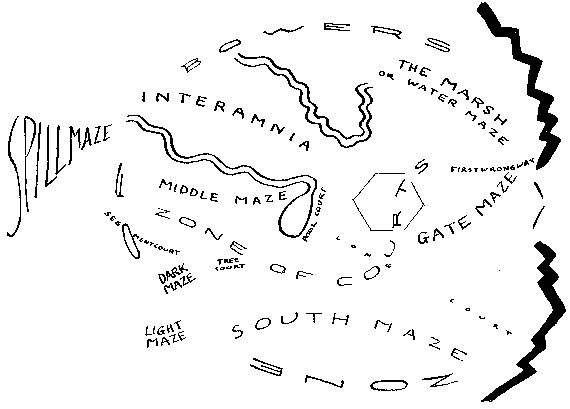 There is a bower one of whose sides is a window with a view along the water.

This is that same canal that, from the public pool near the central court, wmndered out and around the maze and, under bridges, threaded its way back into the neighborhood of the center. From the window you perhaps see a swimmer emerge under your feet, and plow wearily along to pass out of sight at a farther corner.
The hardiest swimmers of all — perhaps you and your partner — persist to find the end of the water. Coming to each wall of glass that bars the way, you must dive under it where you see light. Each farther part of the channel is a cell: people in other parts of the maze may sometimes see into it, but there is no way into it or out of it except by water.
In one place the water, in a trough which is also a bridge, passes over a farther reach of itself.

(A canal crosses the river Whitewater at Odiham Castle by a same-level bridge like this, and doubtless there are other examples. The river appears to stop dead at a bank, and then flow out of a second bank. The principle is obvious, but still amazing when you first see it, like those irrigation pipes in the Middle East that arch into the air over a gateway and then continue flowing at their former level.) In another place, you see a part of the water you have already swum along, separated from you only by a window.

There are ledges where you can crawl ashore to rest.

And there are windows through which you can be seen by people some of whom are near the very beginning of the maze.

You discover the end of the water, where it disappears through a grating. It is a triangle within that mysterious hexagon right next to the entrance of the maze.

The hexagon is a bower, the most privileged of all. A ladder leads from it to the roof. The open maze is very near around; yet it is also remote, far back along an intricate route, all water and parts underground. Yet, again, there is no locked door on the way. Having won your way to this innermost bower, you are very safe from the crowd, but you cannot deny entrance to any other individual swimmers who come through the water. This bower has no door, yet also no solid division between it and the rest of the maze, indeed the rest of the world.
In the glass maze — as to a lesser degree in all of space — there are different senses in which two places are “next to” or “not next to” each other, “in the same area” or “not in the same area,” “separated” or “not separated” by a certain barrier, “near” or “far apart.” Somebody you see through a window is “near” in the sense that he is in the next triangle, and that you see him, but he may be “remote” in the sense that it would take you a long time to get to where he is, or that you will not get there at all.
There are vast outer areas consisting of nothing but branching passages (composed basically of hexagons)

or of intestinal passages (which, in order to leave no redundant triangles, must as they grow always have a boundary free of acute angles and straight lines).

The cancerous prodigality of these areas begins to imitate the universe, which extends itself by the insanely prolonged repetition of elements — a million atoms in a module millions of which are needed to make the thickness of one of the million hairs on a head.
To simplify the maze, you could try to divide it into regions by some strict criteria of form. A first step is to cut off each sac; that is, a region dependent for entry and exit on a single mirage.

You could remove all its internal mirrors and windows and leave it as a hall of pillars (rambling and partly roofless) with one entrance. Some people are in effect imprisoned within the depths of the maze, even though there is no door shut between them and the open street. Or rather, there are some people in the maze who are destined not to find their way out. So they are the prisoners, mingled with and indistinguishable from those who also wander but are not prisoners.
Society (in the street) can see the prisoners by means of glass. (The Panopticon of the utilitarian philosopher Jeremy Bentham was a prison — circular, glass-roofed, with glass-walled cells all around the perimeter, so that the warder in the middle could see all the prisoners. A prison has actually been built like this in Illinois.) Looking from the street into a window or mirror, you see fragments of many people, without knowing which are deep in the maze and which, though reflected many times, are near the entrance. When a person seems to stride toward you, he may be striding away; when he seems to turn away, he may be on the point of emerging beside you. A sloping passage descends from the roof. At its top is a horizontal grille, so that you cannot go through. From time to time the people on the roof drop glass balls through the grille. They are of all sizes from little marbles to large globes. They are of many colors, some containing air twists, bubbles, cloudiness, yin-and-yang division into clear and opaque halves, miniature flowers, coral tufts, and other decorations.
These balls roll down the slope and into the maze among the feet of the mazedwellers. You may pick them up and play marbles with them. They reflect off the mirrors as light does. You use them to study the billiards of reflection among the sixty-degree angles of the maze.
People stumble on these glass balls. Gradually they diffuse through the maze. They are another migrating component in the maze (along with light, people, and water). Some of them roll into the dark acres, where they are more of a hazard; some into the foundry and the smashery. A glass foundry is usually called a glasshouse — one of the eminently ambiguous terms.
The glasshouse is ultimately the center of the maze: it is the nest from which the web is spun, the nucleus at which the matter of the universe is continually created. Or one might compare it to a volcano, since much of the material extruded in eruptions is rhyolitic glass.
(Delectable quotation from a book on Manchester and its Region: “Highly siliceous seatearths, known as ganister, are also of value in making refractory materials.”)
In the foundry stands the Glass Maze's lightning conductor. It is a tower, on the top of which is spread sand (silica, the basic material of all true glasses except the barium oxide glass used in sodium vapour street lamps). When lightning strikes, the sand is fused into fulgurites or rods of natural glass.
From the furnace, glass glides out as a sheet between rollers, floats on molten tin till it is smooth and rigid, and then rolls on to be annealed in the leer, and to be cut into rectangles for the walls, and triangles for the floor and ceiling. There are few other installations, for the product is almost all of these two standard shapes.
The foundry puts out more glass than is needed for the repair of breakgges. It follows that the maze must be expanding.
The maze is expanding not into known territory — territory viewable from the outside, from encircling roads — but into unknown. For since the ground does not remain level, but the maze does, the plane along which the maze expands must take it undergzound, under the mountain which backs the city. Or it is expanding on props, over a lower plain which receives light through the glass sandwich now roofing it (anyone who has flown over the Alps at night when there is fog in the valieys has seen communities under glass); or over a sea.
Actually the maze becomes either a sphere, wrapping the planet, or a plane, tangent to it, according to which method is used for laying each next triangle — spirit level, or extension from the last triangle. Enshrined in a hexagon of windows: a stone, symbol of destruction. The smashery. This is a sub-maze which people pay to enter. Then they are free to smash the sheets of glass of which it is composed. The shattered fragments are later assembled as ornaments or sent to the foundry as cullet (broken pieces which, added to the sand in the furnace, hasten its melting), or are ground.
The smashers leave, sometimes with bleeding feet. But some before getting out meet the animal which is at large in this part of the maze. It is a bull (in a china shop) or a Minotaur (in a labyrinth) At the limits of the maze, there is a last room, a single triangle, containing a phial of ground glass. When used, it is renewed by a hand from outside.
(They say that the stories of murder by means of ground glass — for instance black house slaves murdering their unsuspecting masters by putting grpund glass in food — are impossible. For if the ground glass is in sufficient quantity to do any harm at all, you notice it. Teeth report to brain with a loud crunching, as when you bite sand in a sandwich. So ground glass is a somewhat virtuous weapon, with which you can kill yourself but not anybody else.)
A friend, Iaina Robertson of Iowa, read of this “last room” and next day composed for me a long icy story called “A Last Room,” which ends with Dulcie dissolving into the mirror. There is said to be a small back door out of the maze, though it is not known whether any wanderer has found it or in what part of the world it emerges. Sometimes people get the horrors, need to find their way out at once, and of course cannot. Someone else, understanding the condition of such a person, should tell him to shut his eyes, and should hold his hand and lead him out. This too may take a long time, and the person led may, like a drowning person, be hard to handle — unable to keep his eyes shut or to stop himself dashing through the glass.
The music at the center is a guide.
In fact, given what happens to light in the maze, sound is a better guide than sight. In extreme cases the people on the roof let a glass fiber ladder down into a court, and the panic-stricken person climbs up. Perhaps this is how the people on the roof got there themselves.
More to leading by the hand:
Sometimes long chains of people form, leading and being led. Their very length makes them more confident of finding the way. If the head of the chain meets another part, there are two possibilities: either it is part of the same chain, in which case they have gone around in a circle; or it is part of another chain, which they could join. The only way to find out is for the leader to call, for instance, “One!” and every person behind him to call it in turn. If the call travels back past the same spot, it is the same chain; if, after a reasonable time, it does not, the chain is a different chain; but if the call that arrives is a different one, such as “Two!,” then the situation is more complicated: this is another chain which is somewhere in the same difficulty of having crossed its own track. (Or else the call “One!” has been corrupted into “Two!”) Chains on meeting may merge, becoming the branches of a single river which flows on in search of the way out; but a more intelligent procedure is for a chain to fray itself into several branches, the head of each pressing on to test a different route, but the rear of each maintaining contact with the others. Then when one branch finds the way out, the message is sent back and the other branches all go into reverse. (If two chains of people flow together, each person from one must step between two persons from the other, taking their hands, and a wave of slowness must travel back along both branches; if a chain of people separates into two or more branches, each must move forward more slowly, or else new people must be recruited faster at the rear.) A still more efficient procedure would be for people to form a chain as they enter the maze, thus acting as their own clue of string. Converting this into a guided tour, with messages passed back by each tourist to the next — “Notice the fiberglass boat moored on your left” — “Notice the fiberglass boat moored on your left.“.. — an entrepreneur of the future will no doubt turn even this maze into a safe experience.
As people leave the maze, they may buy from the gatekeeper crystal eyeglasses. These convert the outside world into something of a Glass Maze. To women as they leave, the gatekeeper offers a glass slipper,which they try on.
And those who depart are also invited to study physics textbooks, or the Atlas of Optical Phenomena of Cagnet, Franc#,on and Thrierr, or the catalogues of the Edmund Scientific Company. If they notice devices or principles that can be applied in the Glass Maze — interference, compound lenses, viscous flow of glass, fluorescence, ultraviolet light, image-conducting glass fiber bundles — or if they have perceptions as to the nature of the Maze — a model of heaven? or of hell? of the interrelating paths of lives? of the human brain? or reproductive system? a machine for inducing rearrangement of the mind? a mere treasury of optics or of architectural themes? a necklace for anecdotes? a pretext for generating a pattern? — and think that the maze could be improved accordingly, they are to send their suggestions in writing, with sketches, to the people on the roof. It must be admitted that the Glass Maze has not yet been built and may never be. But in some ways describing it is better than seeing it. Those who see the surface may not be able to see the pattern, and those who do not see the pattern may not be able to see anything more wonderful than what they merely see.
But in other ways seeing it would be better than describing it. The effects which can exist as ideas, which can be envisioned and calculated and described, which are neat in words, must be a small fraction of those which are more accidental, more compound, more personal, and more for the eye than the mind.
To see the Glass Maze imperfectly:
— Make a model of it and lock down into it with a magnifying periscope. — Or make a film of it. This could be done by using a small number of mirrors and people and no windows at all — mimicry instead.
— Or buy a poorboy or a Bar-B-Que beef roll, sit on grass to eat it, then crush the empty transparent wrapper partially flat. Half an hour later this wrapper will be full of ants, scurrying in all directions, trying to find their way out of the corridors and chambers of a Glass Maze formed by the casual wrinkles. Since the Glass Maze does not exist, suggestions as to its spirit, structure, techniques and ornaments have all the more chance of being incorporated; not yet being addressable to the people on the roof, they should be sent to the publishers.
But the author's attention has turned to a building made of magnets. (Or tuning forks. Or tuning forks which are also magnets.) |
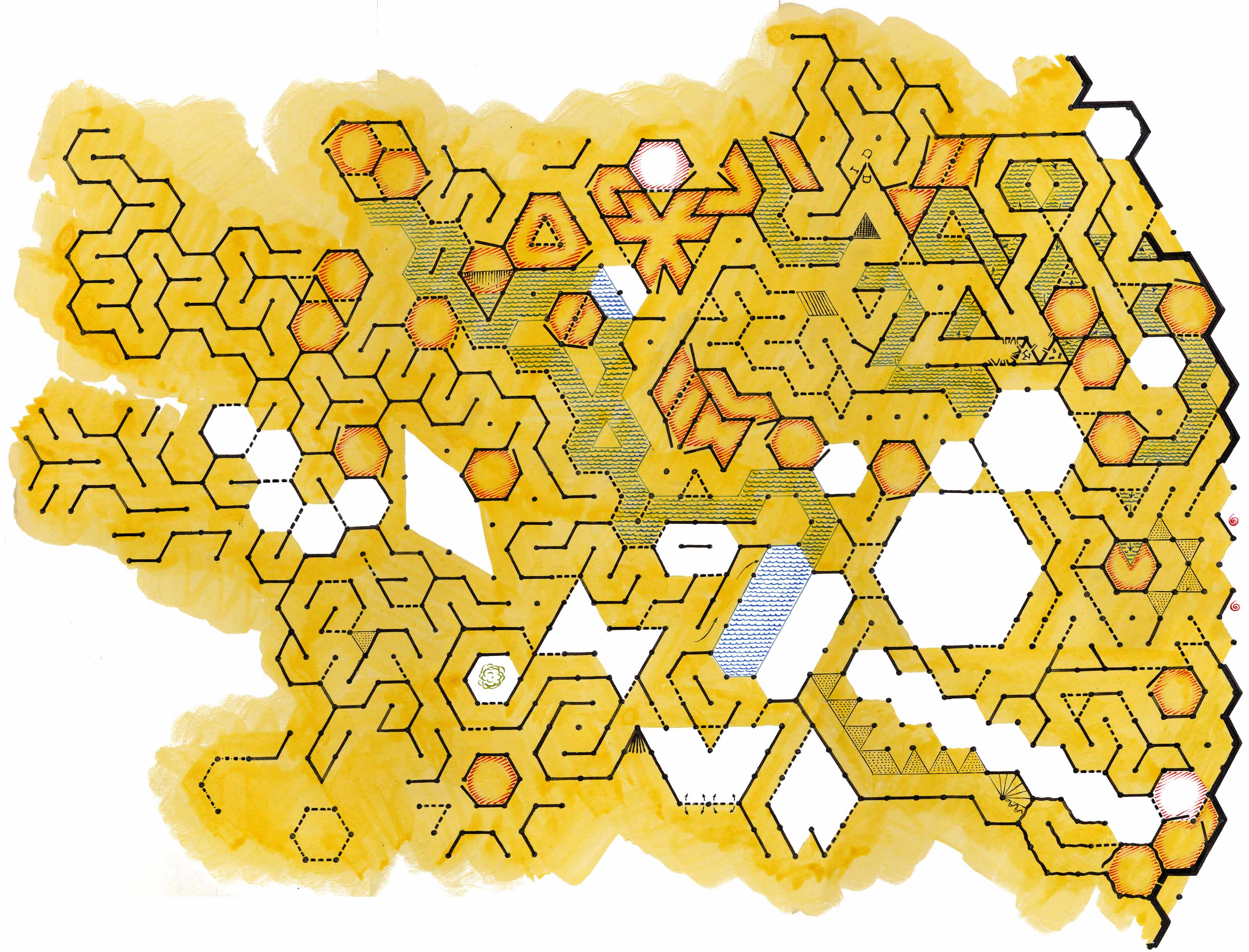
|
